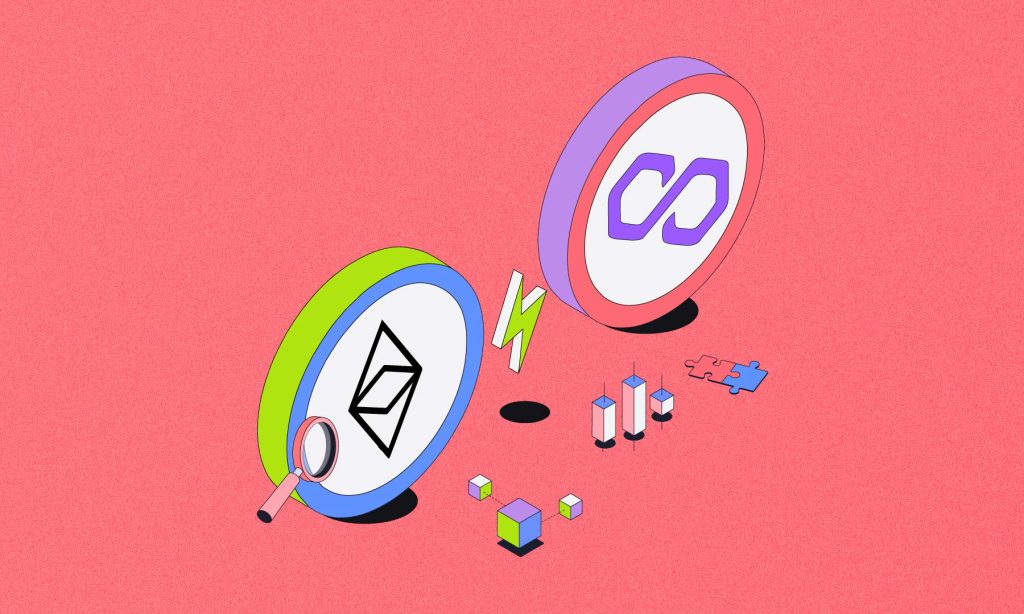Ethereum and Polygon are related cryptos. Polygon was created on the Ethereum blockchain network. So does that mean Ethereum controls Polygon? On the contrary. Keep reading if you want to learn more about this and determine which crypto is better for you.
What is Ethereum?
Let us begin by breaking down what Ethereum is. Ethereum is a blockchain network—like the Bitcoin network. Programmer Vitalik Buterin conceived the idea of Ethereum in 2013. And the network officially saw the light of day on 30 July 2015.
However, unlike Bitcoin, Ethereum allows programmers to write smart contracts and design and operate decentralized applications (dApps). Also, there are no miners on the Ethereum network, although a network of computers runs it. Instead of mining, the computer users stake tokens on the network to earn the right to verify a transaction. When any staker successfully verifies a transaction, they receive a staking fee.
Ethereum has many plusses, but the increasing adoption and uses have led to network congestion and high transaction fees. That’s where Polygon comes in.
What is Polygon?
Polygon’s story begins two years later. Sometime in 2017, four Mumbai-based software engineers launched the MATIC network (currently called Polygon). They aimed to create a Layer-2 scaling solution for Ethereum. That means Polygon was built on top of Ethereum and helps it improve scalability and usability.
Polygon does this by offering faster and cheaper transactions. But does it manage to do so? By using a modified version of Ethereum’s Proof of Stake (PoS) consensus mechanism.
The network also supports the development of dApps in Solidity, the programming language Ethereum uses. Read more about Polygon.
Ethereum vs. Polygon: Detailed analysis
One of the main differences between Ethereum and Polygon is the purpose. Ethereum was designed to build and deploy smart contracts and support the development of dApps in multiple programming languages. Polygon, on the other hand, is a kind of support system for Ethereum. It was created as a Layer-2 scaling solution to help improve Ethereum by making transactions faster and cheaper.
Features
Ethereum takes around 12 seconds to process. This is after the Merge, an important upgrade in recent times. It also has high transaction fees due to its limited scalability. Conversely, Polygon can process up to 7,200 transactions per second and has much lower transaction fees than Ethereum.
The pros of Ethereum and Polygon
You don’t need to be a blockchain guru to see how Polygon is faster and cheaper. The reduced transaction fees and gas costs make it the preferred option of many developers. However, Ethereum is ultimately the parent chain. So there is no Polygon without Ethereum. And the whole point of Polygon is to get Ethereum growing. Besides, the latter is getting better and better with its recent upgrades.
The cons of Ethereum and Polygon
As discussed, Polygon still relies on the Ethereum network for its infrastructure. Moreover, there is limited decentralization as there are fewer validators. Compared to Ethereum, Polygon is the less mature platform, but Ethereum is pretty congested and expensive.
Consensus mechanisms
Polygon and Ethereum use the Proof of Stake (PoS) consensus mechanism. You can read more about this mechanism here. Before 2022, however, Ethereum used to have a Proof of Work mechanism. The adoption of PoS made some wonder whether Polygon would not be redundant and go out of business. But there has been no such impact on Polygon so far.
Transaction speed
Polygon can process up to 7,200 transactions per second and offers much lower transaction fees than Ethereum due to its Layer 2 solutions. This makes Polygon significantly faster and more scalable.
Scalability
As a Layer-2 scaling solution built atop the Ethereum network, Polygon helps support the development of dApps in Solidity. It also comes with a higher transaction speed and lower transaction fees. Additionally, Polygon is interoperable with a range of other blockchains, thanks to the Polygon’s arbitrary message passing. This is why several major crypto projects, such as Aave, SushiSwap, and Decentraland, are integrating with the Polygon network.
However, Ethereum undoubtedly is the largest player in the market with the largest number of dApps. It also comes with a larger market capitalization—second only to Bitcoin.
Conclusion: Which is better?
In conclusion, Polygon is a fast and cheap Layer-2 scaling solution for Ethereum. However, it still relies on Ethereum and is less decentralized compared to it. Overall, the choice between Ethereum and Polygon for developers depends on the specific use case. As an investor, the choice should depend on your research, investment objectives, and risk appetite.
FAQs
Which crypto is better Polygon or Ethereum?
Ethereum is the more established platform with a larger ecosystem and more mature development tools. While Polygon offers faster and cheaper transactions, it is ultimately meant to help Ethereum scale new heights. So they have very different purposes. It’s perhaps unnecessary and counterproductive to say which is better. As an investor, of course, you may choose one or the other based on your budget, investment objectives, and risk appetite.
Is Polygon a good blockchain?
Polygon is great due to its fast and cheap transactions, improved scalability, and growing ecosystem. It is also interoperable with other blockchains, so users can transfer assets across chains. However, Polygon still relies on Ethereum’s security and is less decentralized.
Is Polygon cheaper than Ethereum?
Yes, Polygon is generally cheaper than Ethereum. It has lower transaction fees and gas costs.
How can I buy Polygon crypto?
Polygon’s token MATIC can be bought on various crypto exchanges. The process usually involves creating an account, completing the necessary identity verification, depositing fiat currency, and placing a buy order for MATIC.








